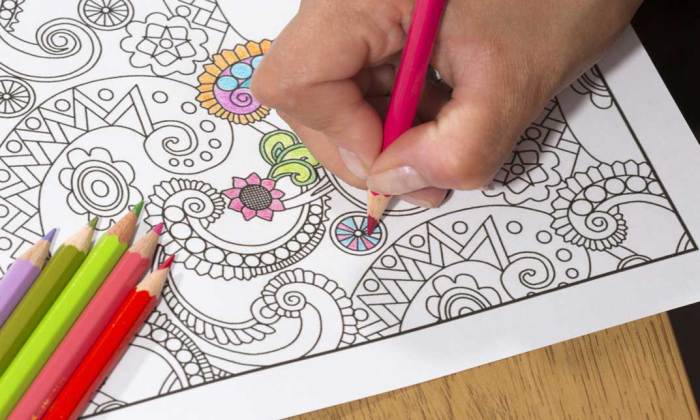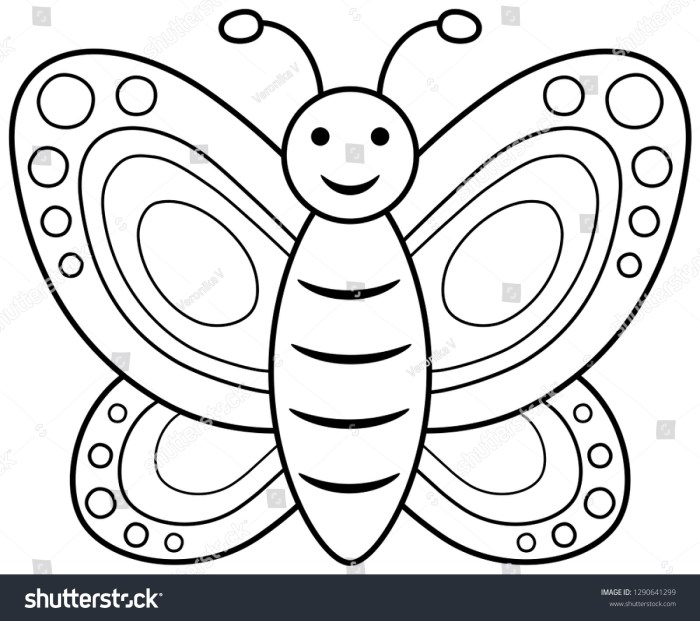Sketching and Designing Images: How To Create A Coloring Book

How to create a coloring book – Creating appealing and easy-to-color images is crucial for a successful coloring book. The key is to strike a balance between simplicity and visual interest, ensuring the designs are engaging for a wide range of ages and skill levels. This involves careful consideration of line weight, detail, and overall style.
The process begins with a rough sketch, allowing for experimentation and refinement before committing to the final line art. This initial phase is vital for establishing the composition, proportions, and overall feel of the image. Avoid overly complex designs in the initial stages, focusing instead on clear shapes and basic forms. Gradually add details as you refine your sketch.
Drawing Styles Suitable for Coloring Books
Different drawing styles lend themselves well to the coloring book format. The choice of style will significantly influence the final aesthetic of your coloring book, impacting its overall appeal and target audience.
- Simple Line Drawings: These utilize clean, bold lines with minimal detail, creating a straightforward design that’s easy for all skill levels to color. Imagine a simple Artikel of a flower with only its petals and stem, devoid of intricate patterns or shading. The focus is on clear shapes and easy color application.
- Geometric Patterns: Incorporating geometric shapes and patterns within the designs creates visually stimulating and satisfying images to color. Think of mandalas, or a stylized animal composed entirely of interlocking triangles and squares. The repetitive nature of these patterns provides a sense of rhythm and structure.
- Whimsical Illustrations: These playful and fantastical images often feature cartoonish characters or objects with exaggerated features. For instance, an illustration of a smiling cat with oversized eyes and a fluffy tail, or a friendly monster with bright colors and simple forms. The expressive nature of these drawings makes them appealing to a younger audience.
- Detailed Intricate Designs: While requiring more time and skill to create, these designs offer a significant challenge and reward for experienced colorists. Imagine a detailed illustration of a castle with numerous windows, turrets, and intricate stonework, providing many areas for detailed coloring and shading.
Creating a Sample Image: Step-by-Step Guide
Let’s create a simple flower. This step-by-step guide will illustrate the process from initial sketch to final line art.
Creating a coloring book involves several steps, from initial concept sketches to final digitalization. For inspiration, you might find browsing through examples helpful, such as the intricate designs offered by creative haven coloring books , which showcase a variety of styles and techniques. Observing their approach can inform your own creative process and help you refine your coloring book’s overall aesthetic and design choices.
- Initial Sketch: Begin with a light pencil sketch. Draw a simple circle for the center of the flower. Then, add several petals around the circle, varying their size and shape slightly for a more natural look. Keep the lines light and loose; this is just a guideline.
- Refining the Sketch: Review your sketch. Adjust the petal shapes and sizes to create a balanced and aesthetically pleasing composition. Erase any unwanted lines. Add a simple stem and leaves.
- Adding Details (Optional): Consider adding subtle details such as veins in the petals or texture to the leaves. However, keep it simple; too much detail can make coloring difficult.
- Inking the Line Art: Once satisfied with the sketch, carefully trace over the lines with a pen or marker. Use a consistent line weight for a clean look. Thicker lines will be more prominent in the final coloring book.
- Final Touches: Erase any remaining pencil marks. Your line art is now ready to be used in your coloring book. Consider adding small details, like a few dots, to the flower center, for extra visual interest.
Image Preparation for Printing
Preparing your artwork for printing is crucial for achieving the desired look and feel in your final coloring book. The quality of your digital images directly impacts the quality of the printed product. Ignoring this step can lead to blurry lines, faded colors, and an overall disappointing result. Therefore, understanding image resolution and file formats is paramount.High-resolution images are essential for crisp, clear prints.
Low-resolution images will appear pixelated and blurry when enlarged, especially in a print format. The detail and vibrancy of your illustrations will suffer significantly, detracting from the overall appeal of your coloring book. Aim for a resolution that’s significantly higher than your intended print size to ensure sharp lines and rich colors.
Suitable File Formats for Printing
Choosing the right file format is important for maintaining image quality and ensuring compatibility with printing presses. Different formats offer varying levels of compression and color support. A common misconception is that JPEG is sufficient; however, for line art and detailed coloring pages, other options are often better suited.
- JPEG (JPG): A widely used format offering good compression, making files smaller. However, it uses lossy compression, meaning some image data is discarded, which can lead to a reduction in quality, especially with repeated saving. It is generally suitable for photographs but may not be ideal for line art or illustrations with sharp details, where preserving the crispness is paramount.
- PNG: A lossless format, meaning no image data is lost during compression. It’s excellent for preserving sharp lines and details, making it a good choice for line art and illustrations in coloring books. However, PNG files can be larger than JPEG files.
- TIFF: Another lossless format offering high image quality and broad color support. It’s often preferred by professional printers, particularly for complex images. However, TIFF files are generally very large, which might affect processing times and storage space.
Optimizing Images for Print
Once you’ve chosen your file format, several steps can further optimize your images for print. These steps ensure your illustrations maintain their vibrancy and detail throughout the printing process. Careful attention to these details will yield a high-quality, professional-looking coloring book.
- Color Mode: Ensure your images are in CMYK (Cyan, Magenta, Yellow, Key/Black) color mode. This is the standard color model for print, as opposed to RGB (Red, Green, Blue) used for screens. Converting from RGB to CMYK might slightly alter colors; therefore, previewing the conversion is recommended.
- Resolution: Aim for a minimum resolution of 300 DPI (dots per inch) for high-quality prints. This is a general guideline, and some printers may require even higher resolutions. Consult your printer for specific requirements.
- File Size: While maintaining high resolution, aim to keep file sizes manageable to avoid potential issues during printing. This can be achieved through proper compression (for lossy formats like JPEG) or optimizing the image without sacrificing quality.
- Line Weight: For line art, ensure lines are thick enough to be clearly visible after printing, but not so thick as to appear heavy or muddy. A line weight of 0.5 to 1 point is usually a good starting point.
Illustrations and Image Descriptions
Creating compelling illustrations is crucial for a successful coloring book, whether aimed at children or adults. The style, complexity, and subject matter must be carefully considered to resonate with the target audience and provide a satisfying coloring experience. The following examples demonstrate the differences in approach between children’s and adult coloring books.
Children’s Coloring Book Illustrations
The illustrations for children’s coloring books should be simple, engaging, and easily colorable. They often feature recognizable characters and scenes from children’s literature or everyday life. The lines should be bold and clear, avoiding intricate details that might frustrate young colorists.
Here are three example illustrations:
- Subject: A playful puppy. Setting: A sunny garden with simple flowers. Color Scheme: Bright and cheerful colors like sunshine yellow, sky blue, grass green, and a vibrant brown for the puppy. The puppy could have playful spots of a contrasting color.
- Subject: A friendly cat sitting on a tree branch. Setting: A whimsical forest with large, simple trees. Color Scheme: Soft pastels – light orange for the cat, various shades of green for the leaves, and a light brown for the tree trunk. The background could use a mix of pale blues and greens.
- Subject: A child blowing bubbles. Setting: A park with a simple swing set in the background. Color Scheme: Rainbow colors for the bubbles, various greens and browns for the park, and bright, happy colors for the child’s clothing.
Adult Coloring Book Illustrations
Adult coloring books often feature more intricate designs, complex patterns, and detailed illustrations. The focus is on providing a relaxing and meditative experience through the process of coloring. These illustrations frequently incorporate mandalas, floral designs, animals with intricate fur patterns, or geometric patterns.
Here are three example illustrations for adult coloring books:
- Subject: A majestic peacock. Setting: A detailed garden with intertwining vines and flowers. Color Scheme: Rich jewel tones – deep blues, greens, and purples for the feathers, with accents of gold and bronze. The background could feature a gradient of complementary colors.
- Subject: A whimsical city skyline. Setting: A fantastical cityscape with detailed buildings and flying creatures. Color Scheme: A mix of warm and cool tones, with a focus on creating depth and shadow. Different shades of grays, blues, and oranges could be used to create a sense of atmosphere.
- Subject: An intricate mandala. Setting: None; the focus is solely on the pattern. Color Scheme: A harmonious palette of complementary or analogous colors. This could be a monochromatic scheme with variations in shading or a vibrant mix of contrasting colors.
Illustrative Styles: Children’s vs. Adult Coloring Books
The primary difference lies in complexity and detail. Children’s books prioritize simplicity and bold lines to ensure ease of coloring for young children. Adult coloring books, conversely, embrace intricacy and detailed patterns to provide a more challenging and meditative coloring experience. Children’s illustrations often focus on recognizable characters and scenes, while adult illustrations tend towards more abstract or symbolic designs.
The color palettes also differ, with children’s books employing bright, primary colors and adult books often favoring more sophisticated and nuanced palettes.
Printing and Binding Options

Choosing the right printing and binding methods for your coloring book is crucial for ensuring a high-quality, durable, and enjoyable final product. The decisions you make here will impact the overall cost, look, and feel of your book. Let’s explore the key considerations.
Printing Methods
Offset printing and digital printing are the two most common methods for producing coloring books. Offset printing is ideal for large print runs due to its cost-effectiveness per unit. The process involves transferring the image from a plate onto a rubber blanket, then onto the paper. This results in crisp, high-quality images, particularly beneficial for intricate coloring page designs.
However, offset printing has higher upfront costs and longer lead times compared to digital printing. Digital printing, on the other hand, is better suited for smaller print runs or those needing quick turnaround times. It prints directly onto the paper, eliminating the need for plates. While offering convenience and speed, digital printing might not achieve the same level of color vibrancy and sharpness as offset printing, especially for very detailed illustrations.
The choice depends on your budget, print quantity, and desired image quality.
Paper Stock Selection
The paper you choose significantly influences the coloring experience. Consider these factors: weight, texture, and bleed. Paper weight, measured in gsm (grams per square meter), determines the paper’s thickness and durability. Heavier weight paper (e.g., 100gsm or higher) is less likely to bleed through, making it ideal for users employing markers or watercolors. Lighter weight paper might be more suitable for crayons or colored pencils.
The paper’s texture also plays a role; a smooth surface might be preferred for detailed work with fine-tipped pens, while a slightly textured paper can provide a more absorbent surface for markers and prevent smudging. Finally, “bleed” refers to the extension of the image beyond the trim line. If you plan to have your images extend to the edge of the page, you’ll need to account for bleed when designing your pages.
A standard bleed allowance is typically 3mm.
Binding Techniques, How to create a coloring book
Several binding methods are available for coloring books, each with its own advantages and limitations. Saddle stitch binding is a cost-effective method suitable for books with a low page count (typically up to 48 pages). Pages are folded in half and stapled along the spine. This method creates a relatively flat book, but it’s not suitable for thicker books.
Perfect binding, on the other hand, is more robust and can accommodate a higher page count. The pages are glued together along the spine, creating a more professional finish. This method is ideal for larger coloring books but can be more expensive than saddle stitch. Other methods, such as spiral binding or wire-o binding, offer flexibility but might not be as aesthetically pleasing for a coloring book.
The best choice depends on the number of pages and your budget. A 64-page coloring book might benefit from perfect binding for durability, while a smaller, 32-page book might be adequately served by saddle stitch binding.



